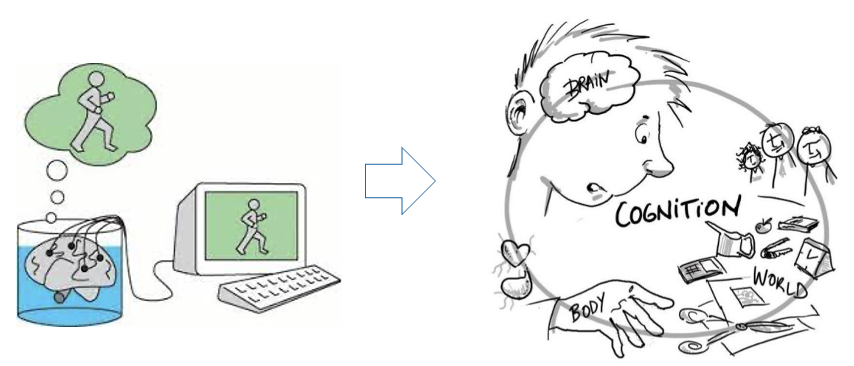4EAP Cognition
In cognitive science and philosophy, the paradigm of 4E cognition (embodied, enactive, embedded, extended) challenges traditional notions of cognition as solely a product of the brain. 4E cognition emphasizes the integral role of the body and environment in shaping human experience and perception.
Likewise, in the context of art engagement, this means that our experience of a painting or sculpture is not confined to visual input alone; rather, it encompasses the entirety of our bodily engagement, from physical movement to emotional response.
The theoretical project aims to highlight the importance of bodily processes and enactive aspects of art engagement by reviewing the theoretical landscapes in sciences of the perceiving and evaluating body. We focus on three aspects: (1) Embodied simulation accounts emphasize the importance of the simulation of depicted actions or artists’ gestures in paintings through motor cortex activation. (2) Furthermore, affective perception suggests that becoming aware of internal bodily changes biases emotion and evaluation. (3) Lastly, in ecological art encounters, perception is not passive but actively brought forth through enactive physical exploration and interaction.
Evaluating philosophical perspectives on the embodiment of artistic engagement, we also integrate empirical research that addresses these aspects, hoping to further motivate empirical aesthetics to investigate the role of the body in art evaluation.
When thinking about being in an art museum looking at art, it is easy believe only our eyes are perceiving, but our body moves too. For example, you might move from artwork to artwork, you might move very close to an artwork, and lean in to look at the details of the brushstrokes, all of which could make a difference for how you experience an artwork (Kühnapfel et al., 2023a). You might also feel moved by an artwork, or feel other emotions, that manifest in your body as physiological changes, such as goosebumps or a faster heartbeat (Cabbai & Kühnapfel et al., 2023). Some artworks, such as installation art are specifically designed to elicit bodily experiences, which are consecutive for the appreciation of a work (Kühnapfel et al., 2023b).
Artworks that have been discussed to elicit embodied simulation via motor cortex activation vis simulation of implicitly depicted actions or explicit art creation gestures by the artist (e.g., see Freedberg & Gallese, 2007; Umiltà et al., 2012; Finisguerra et al., 2021).
References
Cabbai, G., Kühnapfel, C., Fingerhut, J., Kaltwasser, L., Prinz, J. & Pelowski, M. (Submitted on September 3, 2023, to Psychology of Aesthetics, Creativity, and the Arts). Emotion, embodiment, and aesthetic appraisal: The impact of interoceptive abilities and art type. Preprint: https://doi.org/10.31234/osf.io/2dkfx
Finisguerra, A., Ticini, L. F., Kirsch, L. P., Cross, E. S., Kotz, S. A., & Urgesi, C. (2021). Dissociating embodiment and emotional reactivity in motor responses to artworks. Cognition, 212, 104663. https://doi.org/10.1016/j.cognition.2021.104663
Gallese, V., & Freedberg, D. (2007). Mirror and canonical neurons are crucial elements in esthetic response. Trends in Cognitive Sciences, 11(10), 411. https://doi.org/10.1016/j.tics.2007.07.006
Kühnapfel, C., Fingerhut, J., Brinkmann, H., Ganster, V., Tanaka, T., Specker, E., Mikuni, J., Güldenpfennig, F., Gartus, A., Rosenberg, R. & Pelowski, M. (2023a). How do we move in front of art? How does this relate to art experience? Linking movement, eye tracking, emotion, and evaluations in an ecologically-valid gallery setting. Empirical Studies of the Arts, 0(0). https://doi.org/10.1177/02762374231160000
Kühnapfel, C., Fingerhut, J., & Pelowski, M. (2023b). The role of the body in the experience of installation art: A case study of visitors’ bodily, emotional, and transformative experience in Tomás Saraceno’s in orbit. Frontiers in Psychology, 14, 1192689. https://doi.org/10.3389/fpsyg.2023.1192689
Newen, A., Bruin, L., & Gallagher, S. (Eds.). (2018). The Oxford handbook of 4E cognition (1st ed.). Oxford University Press. https://doi.org/10.1093/oxfordhb/9780198735410.001.0001
Umiltà, M. A., Berchio, C., Sestito, M., Freedberg, D., & Gallese, V. (2012). Abstract art and cortical motor activation: An EEG study. Frontiers in Human Neuroscience, 6, 311. https://doi.org/10.3389/fnhum.2012.00311
Varela, F. J., Thompson, E., & Rosch, E. (2016). The embodied mind: Cognitive science and human experience (revised edition). MIT Press.
According to embodied cognition, experience is inherently related to the physical body & active engagement in the environment (Newen et al., 2018; Varela et al., 2016)



